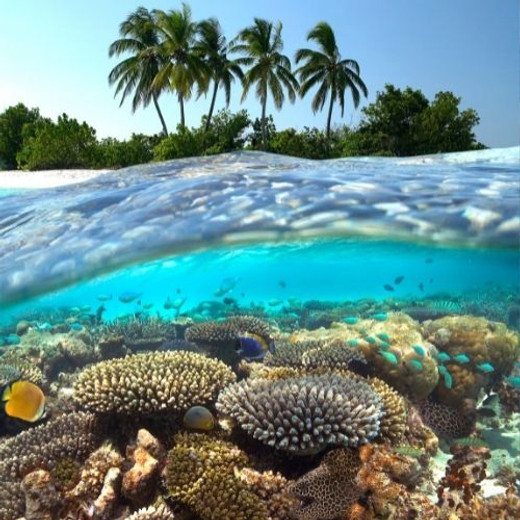Why Are Reef Safe Products Important?
Posted by Ellie Swain on Jun 17th 2021
In the past couple of years, the term ‘reef safe’ has been cropping up into public consciousness.
Reef-safe sunscreen and other products offer formulas that are both safe to the body and the environment. Products that aren’t reef safe aren’t just harmful to our ocean ecosystems, but they aren’t exactly great for our human bodies, especially if exposed from a young age.
The toxic active ingredients found in popular, commonly used sunscreens enter the human bloodstream at much higher levels than U.S. guidelines suggest. The exact primary ingredients in mainstream sunscreens are also damaging our planet’s beautiful coral reefs.
But what makes a skincare product reef safe, and why is it important? Keep reading to learn more.
What Is Reef Safe Sunscreen and Why Should I Be Wearing It?
Reef safe formulas consist of minerals like zinc oxide or titanium dioxide instead of toxic chemicals. They’re the more responsible choice and have no (or at the very least, fewer) harmful effects on our oceans and marine life, making them a reef-safe alternative to usual sunscreens.
If you’re not sure what to choose when shopping for your next bottle, consider that any natural sunscreen is better for the environment than a conventional one. For example, look for options that are organic, non-toxic, or biodegradable.
Keep an eye out for brands that use physical sunblock like titanium or zinc instead of chemical options.
It’s also important to know that some scientists claim that both titanium and zinc settle on the ocean floor and block sunlight. However, this belief isn’t widely accepted. If you want to decide between the two, zinc oxide is renowned for blocking UVA and UVB rays, while titanium oxide only blocks UVB rays.
Reef Friendly Sunscreen Criteria
Reef-friendly criteria are simple to follow if you’re paying attention. For example, sunscreen shouldn’t contain any of the ingredients from ‘The Awful Eight’.
The Awful Eight ingredients are:
- Oxybenzone
- Octinoxate
- Octocrylene
- PABA (Aminobenzoic Acid)
- Enzacamene
- Octisalate
- Homosalate
- Avobenzone
Don’t choose a sunscreen containing any of these ingredients, no matter how many ‘good’ ingredients are in the bottle. Even if one of the eight ingredients is listed, the sunscreen will be a toxic, non-reef friendly formula.
If you read a label on a product claiming something along the lines of ‘natural sunscreen’ or ‘dermatologist approved’, it’s best to know that this doesn’t mean the formula is reef-friendly. Other brands may try to flaunt their inclusion of exotic, super-food ingredients such as beeswax or green tea, claiming to be ‘mineral-based’ sunscreens, but know that there could be plenty of other harmful ingredients present that make it unhealthy for coral reefs.
This sort of dishonest practice is known as ‘greenwashing.’ These companies may claim to be eco-friendly, but you may find that the science doesn’t back up their claims when you do a bit of digging.
When shopping for sunscreen, don’t just read the label but be sure to read the ingredient list. As consumers, we need to take responsibility for what we’re buying and read the ingredients for ourselves.
Reef-Friendly Products
Here at Skin Elite, we have a wide collection of reef-friendly sunscreens so you can enjoy swimming about the ocean guilt-free.
One of our favorite’s is PCA Skin’s Active Protection Body Broad Spectrum SPF 30. The reef-friendly formula is created for protection lying on the beach, hitting the slopes, or anywhere in between. The water-resistant SPF is ideal for those with an active lifestyle.
Plus, it’s also packed full of additional active ingredients that help protect the skin from aging pollutants and other environmental stressors.
To use, apply onto the skin following any cleansing or toning. Allow the formula to absorb for approximately 15 minutes before exposure to the sun. If you’re spending a lot of time outdoors, reapply after two hours of sun exposure and repeat every two hours as necessary.
Another excellent option is Peter Thomas’ Roth Max Matte SPF 45 Protective Dry Cream. This mattifying formula offers water-resistant, broad-spectrum SPF 45 UVA/UVB protection. It works particularly well for oilier skin as it helps absorb excess surface oil with oil-absorbing technology.
The product contains hyaluronic acid and ProHyal+® to hydrate the skin without clogging pores. The formula nicely dries to a sheer, non-sticky, and undetectable matte finish for weightless shine control.
To use, apply the sunscreen liberally before sun exposure. Be sure to reapply at least every two hours to avoid getting any burnt bits.
Shop all of our Reef Safe Skincare Products here.

